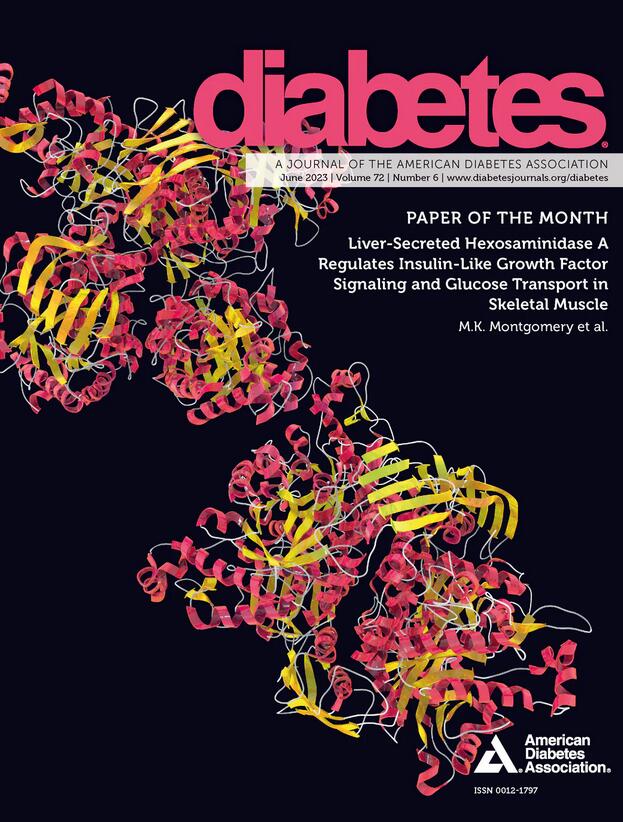17-OR:ADA 主席精选摘要:口服双酚 A 会降低健康成人的外周胰岛素敏感性
IF 6.2
1区 医学
Q1 ENDOCRINOLOGY & METABOLISM
引用次数: 0
摘要
导言:双酚 A(BPA)是一种广泛用于消费品的合成化学物质,在观察性研究中,它与 2 型糖尿病的进展有关。目前还没有实验研究探讨双酚 A 是否会降低外周胰岛素敏感性。研究目的确定口服双酚 A 对外周胰岛素敏感性的影响。方法:40 名非习惯性活跃的健康成年人(22 名女性,18 名男性;21.3 ± 2.5 岁;22.1 ± 2.3 kg/m2;85% 非西班牙裔白人)完成了为期 2 天的低双酚基线能量平衡饮食,在此期间,通过 120 分钟优格高胰岛素血症钳夹技术(40 mU/m2/min;90 mg/dL)对尿液、血液和外周胰岛素敏感性(即葡萄糖输注率/稳态血浆胰岛素)进行了评估。然后以双盲方式将参与者随机分配到 4 天能量平衡饮食加口服 50 μg/kg 体重的双酚 A(BPA-50)或 4 天能量平衡饮食加口服安慰剂(PL)。采用重复测量方差分析对结果进行重新评估,并对基线性别、体重指数、体力活动和种族进行调整。结果从基线到 4 天,PL(平均值 ± SEM;66.7 ± 2.5、66.2 ± 2.5 千克)和 BPA-50 (66.7 ± 2.5、66.7 ± 2.5 千克)之间的体重差异不大(P>0.05)。从基线到 4 天,PL(95 ± 2,88 ± 2 mg/dL)和 BPA-50 (92 ± 2,92 ± 2 mg/dL)之间的空腹血糖差异不显著(P > 0.05)。与 PL 相比,BPA-50 后尿液中的 BPA 明显更高(P<0.05)。从基线到 4 天,BPA-50 的外周胰岛素敏感性明显下降(P=0.01)(0.11 ± 0.01,0.10 ± 0.01 mg/kg/min/uU/ml),而 PL 的外周胰岛素敏感性保持稳定(0.09 ± 0.01,0.10 ± 0.01 mg/kg/min/uU/ml)。结论给药四天后,双酚 A 会降低外周胰岛素敏感性。这些数据首次提供了实验证据,证明服用双酚 A 可增加 2 型糖尿病风险。由美国糖尿病协会资助 #1-19-ICTS-044。披露 A. Seal:无。S.K. Malin:无。A. Schaffner:无:无。M.R. Hubbard:无。S.K. Keadle:无。H. Brunner-Gaydos:H. Brunner-Gaydos: None.A.A. Ortiz: None.J.E. Nakamura: None.C. McMahon:无。R. Barnett: None.A.H. Kelleher:K.A. Bennion: None.K.A. Bennion:无。S. Phelan:研究支持;Weight Watchers International。T. Hagobian:无。资助机构 美国糖尿病协会 (1-19-ICTS-044)本文章由计算机程序翻译,如有差异,请以英文原文为准。
17-OR: ADA Presidents' Select Abstract: Oral Bisphenol A Administration Decreased Peripheral Insulin Sensitivity in Healthy Adults
Introduction: Bisphenol A (BPA) is a synthetic chemical widely used in consumer goods and is linked to Type 2 diabetes progression in observational studies. No experimental studies have examined whether BPA promotes reductions in peripheral insulin sensitivity. Objective: To determine the effects of oral BPA administration on peripheral insulin sensitivity. Methods: Forty non-habitually active, healthy adults (22 F, 18 M; 21.3 ± 2.5 yr; 22.1 ± 2.3 kg/m2; 85% Non-Hispanic White) completed a 2-day baseline energy balance diet low in bisphenols during which urine, blood, and peripheral insulin sensitivity (i.e., glucose infusion rate/steady-state plasma insulin) via 120 min euglycemic hyperinsulinemic clamp technique (40 mU/m2/min; 90 mg/dL) were assessed. Participants were then randomly assigned, in a double-blinded fashion, to a 4-day energy balance diet plus oral BPA administration at 50 μg/kg body weight (BPA-50) or 4-day energy balance diet plus oral placebo (PL) administration. Outcomes were reassessed using a repeated measures ANOVA adjusting for baseline sex, BMI, physical activity, and ethnicity. Results: From baseline to 4-days, body weight was not significantly (P>0.05) different between PL (mean ± SEM; 66.7 ± 2.5, 66.2 ± 2.5 kg) and BPA-50 (66.7 ± 2.5, 66.7± 2.5 kg). From baseline to 4-days, fasting blood glucose was not significantly (P > 0.05) different between PL (95 ± 2, 88 ± 2 mg/dL) and BPA-50 (92 ± 2, 92 ± 2 mg/dL). Compared to PL urine BPA was significantly higher (P<0.05) following BPA-50. From baseline to 4-days, peripheral insulin sensitivity significantly (P=0.01) decreased in BPA-50 (0.11 ± 0.01, 0.10 ± 0.01 mg/kg/min/uU/ml) and remained stable in PL (0.09 ± 0.01, 0.10 ± 0.01 mg/kg/min/uU/ml). Conclusion: BPA administration decreased peripheral insulin sensitivity after four days. These data provide the first experimental evidence that BPA administration may increase Type 2 diabetes risk. Supported by American Diabetes Association grant #1-19-ICTS-044. Disclosure A. Seal: None. S.K. Malin: None. A. Schaffner: None. M.R. Hubbard: None. S.K. Keadle: None. H. Brunner-Gaydos: None. A.A. Ortiz: None. J.E. Nakamura: None. C. McMahon: None. R. Barnett: None. A.H. Kelleher: None. K.A. Bennion: None. S. Phelan: Research Support; Weight Watchers International. T. Hagobian: None. Funding American Diabetes Association (1-19-ICTS-044)
求助全文
通过发布文献求助,成功后即可免费获取论文全文。
去求助
来源期刊

Diabetes
医学-内分泌学与代谢
CiteScore
12.50
自引率
2.60%
发文量
1968
审稿时长
1 months
期刊介绍:
Diabetes is a scientific journal that publishes original research exploring the physiological and pathophysiological aspects of diabetes mellitus. We encourage submissions of manuscripts pertaining to laboratory, animal, or human research, covering a wide range of topics. Our primary focus is on investigative reports investigating various aspects such as the development and progression of diabetes, along with its associated complications. We also welcome studies delving into normal and pathological pancreatic islet function and intermediary metabolism, as well as exploring the mechanisms of drug and hormone action from a pharmacological perspective. Additionally, we encourage submissions that delve into the biochemical and molecular aspects of both normal and abnormal biological processes.
However, it is important to note that we do not publish studies relating to diabetes education or the application of accepted therapeutic and diagnostic approaches to patients with diabetes mellitus. Our aim is to provide a platform for research that contributes to advancing our understanding of the underlying mechanisms and processes of diabetes.
 求助内容:
求助内容: 应助结果提醒方式:
应助结果提醒方式:


